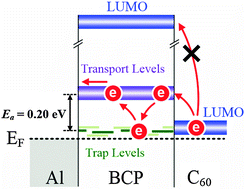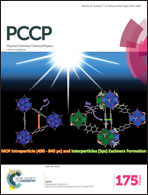Electron transport mechanism of bathocuproine exciton blocking layer in organic photovoltaics
Abstract
Efficient exciton management is a key issue to improve the power conversion efficiency of organic photovoltaics (OPVs). It is well known that the insertion of an exciton blocking layer (ExBL) having a large band gap promotes the efficient dissociation of photogenerated excitons at the donor–acceptor interface. However, the large band gap induces an energy barrier which disrupts the charge transport. Therefore, building an adequate strategy based on the knowledge of the true charge transport mechanism is necessary. In this study, the true electron transport mechanism of a bathocuproine (BCP) ExBL in OPVs is comprehensively investigated by in situ ultraviolet photoemission spectroscopy, inverse photoemission spectroscopy, density functional theory calculation, and impedance spectroscopy. The chemical interaction between deposited Al and BCP induces new states within the band gap of BCP, so that electrons can transport through these new energy levels. Localized trap states are also formed upon the Al–BCP interaction. The activation energy of these traps is estimated with temperature-dependent conductance measurements to be 0.20 eV. The Al–BCP interaction induces both transport and trap levels in the energy gap of BCP and their interplay results in the electron transport observed.


 Please wait while we load your content...
Please wait while we load your content...